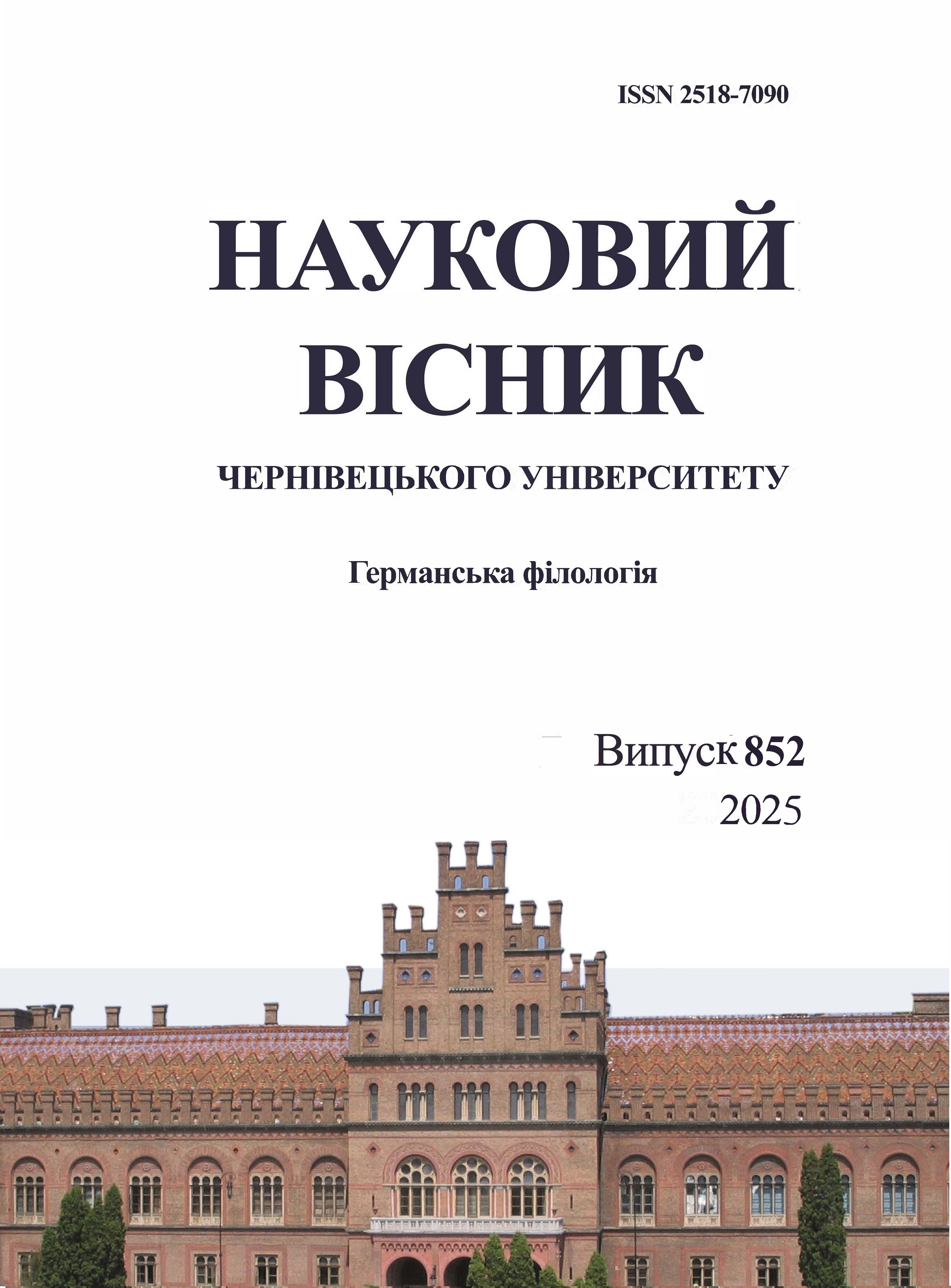STRUCTURАL CHARACTERISTICS OF MODERN GERMAN TOPONYMS
DOI:
https://doi.org/10.31861/gph2025.852.67-77Keywords:
German language, structure, derivation, word-formation model, oikonym, oronym, hydronym, toponymyAbstract
The article is devoted to establishing the structural characteristics of toponyms based on the material of modern German, selected from the latest lexicographical and cultural studies sources. The object of the study is toponyms functioning in contemporary German-speaking countries, while the subject is their word-formation features.
Through structural analysis of German toponyms, several groups were identified and analyzed: simple, non-suffixal and suffixal derivatives, shifts, compound, and multi-lexeme toponyms. These groups reflect the diversity of structural forms used in naming geographical objects. Among the most typical bases, elements such as -heim, -hausen (-haus), -leben, -hof, -hofen, -statt, -stedt, -stätten, -dorf, -wiek, -weiler (-weil), -richt, -graben, -bach, and -apa stand out. Their frequency of use indicates a systematic approach to the formation of the German toponymic system.
The emergence of a large number of toponyms in the German language is associated with significant changes in the cultural, social, and historical life of the German ethnos. These changes were reflected in the development of new territories, the creation of new settlements, and the naming of large and small geographical objects. Migration processes driven by political and economic factors played an essential role in preserving naming traditions in new territories, sometimes even with the complete transfer of old toponyms.
The expansion of Germans' geographical and linguistic worldview enriched the onomastic system with new word-formation models, demonstrating the dynamic development of German toponymy and its importance in cultural and linguistic spaces.
Downloads
References
СПИСОК ЛІТЕРАТУРИ
Білоус І.Л. Власні назви у німецьких газетно-публіцистичних жанрах: автореф. дис. ... канд. філол. наук: 10.02.04. Херсон, 2014. 19 c.
Кійко С.В. Омонімія апелятивів і топонімів. Наукові праці Камʼянець-Подільського національного університету імені Івана Огієнка. Філологічні науки. Камʼянець-Подільський: Аксіома, 2013. Вип. 32. С. 196–200.
Кійко С.В. , Кійко Ю.Є. Вступ до германського мовознавства: навчальний посібник. Чернівці: ЧНУ, 2022. 228 с.
Кійко С.В., Якубович І. Семантичні характеристики топонімів Німеччини. Науковий вісник Чернівецького національного університету імені Юрія Федьковича. Германська філологія. Чернівці: ЧНУ, 2023. Вип. 843. C. 36-46.
Кійко Ю.Є. , Кійко С.В. Лінгвокраїнознавчий словник. Чернівці: ЧНУ, 2009. 84 с.
Кійко Ю.Є. Nomina propria в німецькому й українському інформаційних зовнішньополітичних дискурсах. Слов’янський збірник. Київ: Вид-во С.Будаго, 2012. Вип. 17. Ч. 1. С. 353–358.
Кійко Ю.Є., Найдеш О.В. Deutschsprachige Landeskunde: навчальний посібник. Чернівці: Чернівецький національний університет імені Юрія Федьковича, 2021. 96 с.
ADAC Kompaktatlas Deutschland. 24. Aufl. Ostfildern: MAIR¬DUMONT, 2024. 236 S.
Bach A. Deutsche Namenkunde. Bd. I-ІІ. Heidelberg: Winter, 1952-1954. 331 S. 451 S. 615 S.
Berger D. Geographische Namen in Deutschland: Herkunft und Bedeutung der Namen von Ländern, Städten, Bergen und Gewässern. Duden Taschenbücher, Bd. 25. 1999. 320 S.
Fleischer W. Struktur und Funktion mehrwortigen Eigennamen im Deutschen. Reader zur Namenkunde: Germanistische Linguistik. Bd. 1: Namentheorie. Olms, 1989. S. 263–271.
Koß G. Namenforschung. Eine Einführung in die Onomastik. Tübingen: Niemeyer, 2012. 248 S.
Nübling D., Fahlbusch F., Heuser R. Namen: Eine Einführung in die Onomastik. 2. Aufl. Tübingen: Narr, 2015. 374 S.
REFERENCES
Bilous I.L. (2014). Vlasni nazvy u nimetskykh hazetno-publitsystychnykh zhanrakh [Proper Names in German Newspaper and Journalistic Genres]: avtoref. dys. ... kand. filol. nauk: 10.02.04. Kherson, 2014. 19 s.
Kiyko S. V. (2013). Omonimiya apelyatyviv i toponimiv [Homonymy of appellations and toponyms]. Naukovi pratsi Kamyanets-Podilskoho natsionalnoho universytetu imeni Ivana Ohiyenka. Filolohichni nauky. Kamyanets-Podilskyy: Axioma, 2013. Vol. 32. S. 196–200.
Kiyko S.V., Kiyko Yu.Ye. (2022). Vstup do hermanskoho movoznavstva [Introduction to Germanic Linguistics]: navchalnyi posibnyk. Chernivtsi: ChNU, 2022. 228 s.
Kiyko S.V., Yakubovych I. (2023). Semantychni kharakterystyky toponimiv Nimechchyny [Semantic characteristics of German toponyms]. Naukovyi visnyk Chernivetskoho natsionalnoho universytetu imeni Yuriia Fedkovycha. Hermanska filolohiia. Chernivtsi: ChNU, 2023. Vol. 843. S. 36-46.
Kiyko Y., Kiyko S. (2009). Linhvokrainoznavchyi slovnyk [Linguo-Country Dictionary]. Chernivtsi: ChNU, 2009. 84 p.
Kiyko Y. (2012). Nomina propria v nimetskomu y ukrainskomu informatsiinykh zovnishnopolitychnykh dyskursakh [Nomina propria in German and Ukrainian foreign policy information discourses]. Slovianskyi zbirnyk. Kyiv: Vyd-vo S.Budaho, 2012. Vol. 17. Ch. 1. S. 353–358.
Kiyko Y., Naidesh O. (2021). Deutschsprachige Landeskunde [German-language regional studies]: navchalnyi posibnyk. Chernivtsi: Chernivetskyi natsionalnyi universytet imeni Yuriia Fedkovycha, 2021. 96 s.
ADAC (2024) Kompaktatlas Deutschland [Compact Atlas of Germany]. 24. Aufl. Ostfildern: MAIR-DUMONT. 236 S.
Bach A. (1952-1954) Deutsche Namenkunde [German Naming]. Bd. I-ІІ. Heidelberg: Winter. 331 S. 451 S. 615 S.
Berger D. (1999) Geographische Namen in Deutschland [Geographical names in Germany]: Herkunft und Bedeutung der Namen von Ländern, Städten, Bergen und Gewässern. Duden Taschenbücher, Bd. 25. 320 S.
Fleischer W. (1989) Struktur und Funktion mehrwortigen Eigennamen im Deutschen [Structure and function of multi-word proper names in German]. Reader zur Namenkunde: Germanistische Linguistik. Bd. 1: Namentheorie. Olms. S. 263–271.
Koß G. (2012) Namenforschung [Onomastics]. Eine Einführung in die Onomastik. Tübingen: Niemeyer. 248 S.
Nübling D., Fahlbusch F., Heuser R. (2015) Namen: Eine Einführung in die Onomastik [Name: An Introduction to Onomastics]. 2. Aufl. Tübingen: Narr. 374 S.






